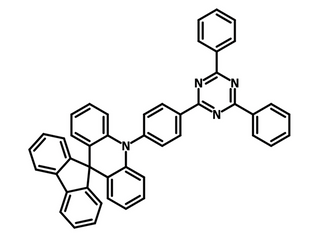SpiroAC-TRZ
CAS Number 1980037-96-4
Blue Dopant Materials, Dopant Materials, High Purity Sublimed Materials, Materials, OLED Materials, Semiconducting Molecules,A Blue-Emitting Organic Semiconductor
For the fabrication of highly efficient TADF-OLEDs
SpiroAC-TRZ (CAS number 1980037-96-4) is designed with a spiroacridine donor covalently linked to a triazine acceptor unit. It functions as a blue-emitting organic semiconductor, exhibiting thermally activated delayed fluorescence (TADF).
SpiroAC-TRZ demonstrates a strong horizontal dipole ratio up to 83% and photoluminescence quantum yield of near 100%. Due to the small singlet-triplet energy gap (ΔEST) of 0.072 eV, the reverse intersystem crossing and related processes readily occur in SpiroAC-TRZ. An OLED device featuring SpiroAC-TRZ shows an extraordinarily high external quantum efficiency of 36.7%, with a current efficiency of 72 cd/A and a power efficiency of 84 lm/W.
As a third-generation OLED emitter, spiroAC-TRZ is also employed in the fabrication of simplified single-layer blue-emitting OLEDs. The emitting layer of SpiroAC-TRZ is situated between ohmic contacts of PEDOT:PSS:PFI anode and Ba/Al cathode. This single-layered OLED exhibits EQE of 27.7% with minimal roll-off, maintaining an EQE of 23% at luminance of 1000 cd/m2.
TADF emitter
Achieves high external quantum efficiency of 36.7%
Worldwide shipping
Quick and reliable shipping
Demonstrate near-unitary PLQY
Near 100% photoluminescence quantum yield
Sublimed grade purity
>99% Grade purity
General Information
| CAS Number | 1980037-96-4 |
|---|---|
| Full Name | 10-(4-(4,6-Diphenyl-1,3,5-triazin-2-yl)phenyl)-10H-spiro[acridine-9,9'-fluorene] |
| Chemical Formula | C46H30N4 |
| Molecular Weight | 638.76 g/mol |
| Purity | Sublimed >99% (HPLC) |
| Fluorescence | λmax = 479 nm (toluene) [1] |
| HOMO/LUMO |
HOMO = −5.7 eV LUMO = −3.1 eV [1] |
| Decomposition Temperature | Td = 353 °C [1] |
| Glass Transition Temperature | Tg = 155 °C [1] |
| Processing Solvents | Toluene |
| Appearance | Pale yellow powder |
| Synonyms | SpiroAc-TRZ |
| Classification or Family | Emitting layers, Blue emitter, Dopant materials, Acridines, Triazines, TADF blue emitters, Sublimed materials, TADF OLEDS |
Chemical Structure
Device Structure(s)
| Device Structure | ITO/MoO3/TAPC/mCP/12 wt% SpiroAC-TRZ:mCPCN/3TPYMB/LiF/Al [1] |
|---|---|
| Color |
|
| External Quantum Efficiency | 36.7% |
| Current Efficiency | 94 cd/A |
| Power Efficiency | 98.4 lm/W |
| Turn On Voltage | 2.0 V |
| Device Structure | PEDOT:PSS:PFI (20 nm)/SpiroAC-TRZ:mCPCN(1:1, 80 nm)/Ba (2.5 nm)/Al (100 nm) [4] |
|---|---|
| Color |
|
| External Quantum Efficiency | 27.7% |
| Current Efficiency | 94 cd/A |
| Power Efficiency | 84 lm/W |
| Turn On Voltage | 2.53 V |
*For chemical structure information, please refer to the cited references.
MSDS Documentation
Pricing
| Product Code | Quantity | Price |
|---|---|---|
| M2435A1 | 100 mg | £200 |
| M2435A1 | 250 mg | £400 |
| M2435A1 | 500 mg | £650 |
| M2435A1 | 1 g | £1040 |
Literature and Reviews
- Sky-blue organic light emitting diode with 37% external quantum efficiency using thermally activated delayed fluorescence from spiroacridine-triazine hybridT. -A. Lin et al., Adv. Mater., 28, 6976–6983 (2016); DOI: 10.1002/adma.201601675.
- Purely organic thermally activated delayed fluorescence materials for organic light-emitting diodes, M. Wong et al., Adv. Mater., 29, 1605444 (2017); DOI: 10.1002/adma.201605444.
- A brief history of OLEDs — emitter development and industry milestones, G. Hong et al., Adv. Mater., 33, 2005630 (2021); DOI: 10.1002/adma.202005630.

